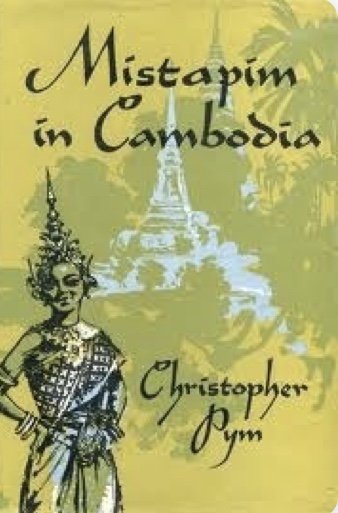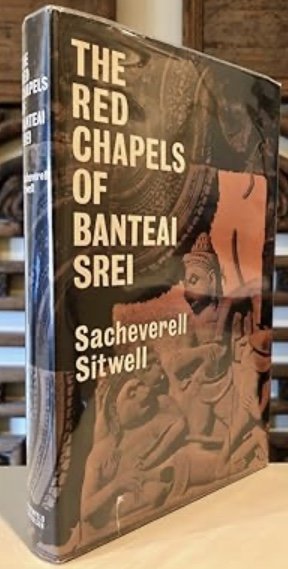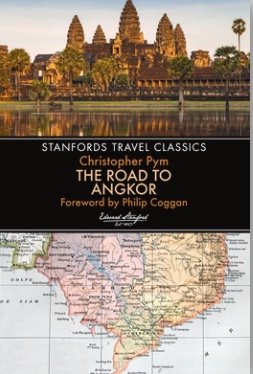Mistapim in Cambodia by Christopher Pym (Hodder & Stoughton)
Not many people traveled to Angkor Wat in 1954. The French War in Vietnam, which had spilled into Cambodia, had just ended. Although it remained a French colony until the end of the year, Cambodia was too absorbed with preparing itself as a newly independent nation to concern itself with tourism.
It was a Thai prince who organized a sightseeing expedition to Angkor and a member of this group was a young Englishman who was working in what was at that time called Malaya. At 25, Christopher Pym was still young enough to swerve from secure employment into charting his own adventure and when he fell in love with the glories of the ancient Khmer empire, this is what he did.
He began an intensive study of Cambodian history and the Khmer language, moving to Phnom Penh in 1956 without a safety net, determined to “carve one’s own set of circumstances,”
In Malaya, his life had been comfortable. The business firm Pym had worked for in that country had provided everything--”car, house,cook, gardener, cocktails, and so on.” This isn’t the way he wants to live in Cambodia; he finds a wooden house on stilts on the outskirts of Phnom Penh and almost immediately comes down with dengue fever. Moving back to the city, he rents a small room that is next to a shrine for a Chinese deity. His domestic comforts are limited to a bed, a table, and a wooden crate, but unlike his first home, this place has electricity and a rudimentary bathroom.
Learning Khmer and teaching English gives Pym the life he wants, with freedom to travel in search of “the heart of the Khmer people.” After an evening of opium-smoking at the home of a French acquaintance, he decides he isn’t going to find the heart of Cambodia in the company of Europeans in Phnom Penh and he begins to explore village life.
While urban Cambodians are jaded when it comes to foreigners, Pym is a delightful novelty to rural communities who are more than willing to let him witness and chronicle their ways of life. Although he has fleeting contacts with Cambodia’s royal family, Pym becomes close to people of less exalted lineage and he much prefers to spend his time with them.
Perhaps his favorite brush with royalty is when he’s a spectator at the funeral of one of the princes of the realm. The royal tomb has gone unused for many years and “a combined attack of blunt pickaxes and old crowbars” fail to open the entrance--until a member of the King’s family grabs a pickaxe, throws his jacket aside and leads “a continuing onslaught,” royal privilege be damned.
But any prince of the realm pales beside Pym’s friendship with Om, “a kind of Khmer teddy-boy.” Westernized but “not a delinquent,” Om opens village life and its daily life in a way no prince could ever have done. Because of him, Pym is given free access to Buddhist ordinations, engagement ceremonies, and “ a positively Aristophanic marriage-feast.”. He describes all of these events in photographic detail and with deep respect, without a trace of condescension or British snark.
Even in Phnom Penh, which clearly isn’t his favorite place in Cambodia, he only allows himself a tiny tinge of bitterness when he comes across “a milkbar neon-lit,” and thinks, “Well done, Cambodia, the same as everywhere else at last.”
Pym was lucky--he took up residence in Cambodia when ceremonies and rituals and village life still mirrored what was carved in bas-relief on the walls of the Bayon and Angkor Wat. He journeyed to the distant reaches of the kingdom by oxcart during the rainy season to view the citadel of Bantei Chmar, before looters dismantled it “stone by stone.” And he was invited to see a performance of the Royal Khmer Ballet within the royal palace, watching “the eloquent hands of the Khmer dancers” as they performed The Abduction of Sita from the Ream Ker, the Khmer Ramayana.
There are hints of change in Pym’s accounts--electric lights replacing the gigantic candle that illuminates the months when monks retreat to their temples, an American “education center” being built in the countryside, and rebel insurgents preventing a journey to a village near the Thai border. As the “temptation to go to Samrong just for fun increased in proportion as the police insisted upon my not going there,” Pym, respectful as always, doesn’t break his word.
The only facetious part of this book is its title, which Pym at the outset assures readers “was chosen by the publishers.” Although he can’t resist flashes of humor, he writes with a scrupulous lack of judgment that an anthropologist would envy and gives meticulous glimpses of Cambodian life that are worthy of Zhao Daguan, back in the days of the Angkor Empire. Thank you, Mistapim.~Janet Brown


